The Red Tail Shark (Epalzeorhynchos bicolor) is a fascinating freshwater fish known for its striking appearance. With a vivid black body and a contrasting red tail, it’s a popular choice among aquarium enthusiasts. Native to Thailand, this species has an intriguing behaviour known as ‘territorial mimicry.’ Unlike other fish, Redtail Sharks often imitate more aggressive species to establish dominance without actual confrontation.
Reaching up to 15cm in length, they require specific care, including proper tank conditions and suitable tank mates. Rarely found in the wild nowadays, their captive care continues to intrigue and challenge aquarists, reflecting a unique blend of beauty and behavioural complexity.
Table of Contents

Stats and Details
| Red Tail Shark Fact: | Details |
| Scientific Name: | Epalzeorhynchos bicolor |
| Care Level: | Moderate |
| Native Region: | Southeast Asia, mainly Thailand |
| Lifespan: | Up to 6 years in optimal conditions |
| Size: | Up to 15 centimetres |
| Family: | Cyprinidae |
| Diet: | Omnivore |
| Minimum Tank Size: | 75 litres for a single fish |
| Compatibility: | Best with non-aggressive species that aren’t similar in appearance |
Red Tail Shark Origin and Availability
The Red Tail Shark’s origins trace back to the freshwater basins of Thailand, particularly in the Chao Phraya River. Historically thriving in fast-flowing streams and rivers with dense vegetation, these sharks have adapted to a wide range of water conditions.
However, a unique and alarming fact about their natural habitat is the near extinction in the wild, primarily due to overfishing and habitat loss. Currently, almost all Redtail Sharks in the aquarium trade are bred in captivity.
While they remain widely available for aquarists, the captive breeding ensures their survival, as their natural populations have dwindled to alarming levels. Efforts to conserve and protect this captivating species are ongoing, reflecting a complex interplay between their natural existence and human intervention.
Conservation
The Red Tail Shark’s conservation story is one marked by both concern and commitment. Once abundant in Thailand’s Chao Phraya River, their numbers in the wild have dramatically declined. Overfishing and habitat destruction are major culprits, leading to their classification as a critically endangered species.
Unique to their conservation is the prominent role played by aquarium owners and breeders. By maintaining healthy populations in captivity, they have helped preserve the species. Conservation organisations and local authorities are working together to restore natural habitats and implement protective regulations.
The journey of the Redtail Shark from abundance to scarcity, and the concerted efforts to protect them, serves as a rare and inspiring example of collaboration between hobbyists and conservationists in the world of aquatics.
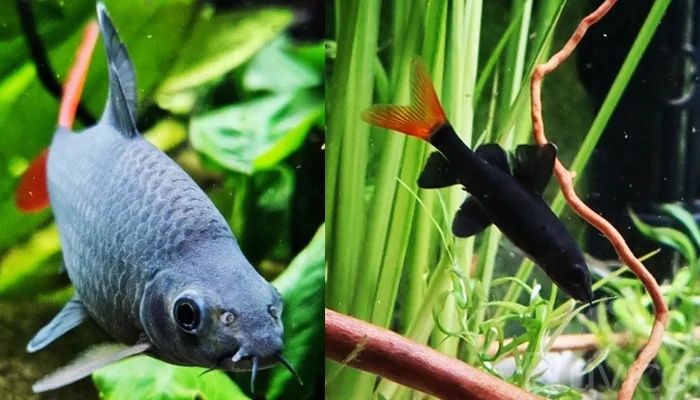
Appearance and Behaviour
Adult Size & Lifespan
The Red Tail Shark is renowned for its vibrant appearance and dynamic personality, growing to an adult size of approximately 15 centimetres (6 inches) in length. It’s an essential aspect for potential keepers to consider, as the fish’s size necessitates specific tank requirements to ensure comfort and health.
The lifespan of the Redtail’s is equally notable, with well-cared-for individuals often living up to 8 to 10 years in captivity. This longevity requires a long-term commitment from the aquarist, with consistent attention to diet, water quality, and overall habitat.
The Redtail Shark’s size and lifespan represent more than mere statistics; they are key factors in the understanding and planning needed for the responsible and successful keeping of this remarkable species. Ensuring an environment that accommodates its adult size and supports its potential lifespan is integral to the ethical care of the Redtail Shark.
Colours, Patterns, Fins, and Sex Differences
The Red Tail Shark (Epalzeorhynchos bicolor) presents an eye-catching combination of colours and patterns that makes it a favourite in the aquarium world. Its vibrant black body is contrasted sharply by its namesake, a fiery red tail, creating a visual spectacle in the tank. The bold colouration is not only a unique feature but serves a purpose in communication and territorial display among the species.
The fins of the Red Tail Shark are streamlined, and the red hue typically extends to the dorsal and anal fins. The distinction between males and females is subtle and often challenging to discern, especially in younger specimens. Males tend to have a more intense red colouration and a slightly slimmer body, whereas females may appear more robust. These variations in colours, patterns, and fin shapes contribute to the Redtail Shark’s allure.
The sex differences, while subtle, add an extra layer of complexity for enthusiasts keen on understanding and possibly breeding this fascinating species. Together, these attributes make the Redtail Shark a captivating subject both for visual enjoyment and biological study.
Behaviour & Temperament
The behaviour and temperament of the Red Tail Shark are as distinctive as its vibrant appearance. Known for their territorial nature, Red Tail Sharks often exhibit a dominant streak, particularly within their claimed areas. This territoriality can extend to mimicking more aggressive species to deter potential threats – a rare phenomenon known as ‘territorial mimicry.’
Despite their assertive nature, Red Tail Sharks are generally not aggressive towards species that don’t resemble other bottom-dwelling fish. They can be successfully housed with various tank mates, as long as sufficient space and hiding spots are provided to avoid conflicts. Young Redtail Sharks tend to be more sociable, but as they mature, their inclination to establish and defend territory becomes more pronounced.
Understanding this behavioural progression is key to maintaining a harmonious aquarium environment. While their territorial nature may seem daunting, with careful planning and attention to their specific needs, Redtail Sharks can become a fascinating centrepiece in a community tank. Their complex behaviours offer continual insight into their unique personalities, providing both challenge and reward for the attentive aquarist.
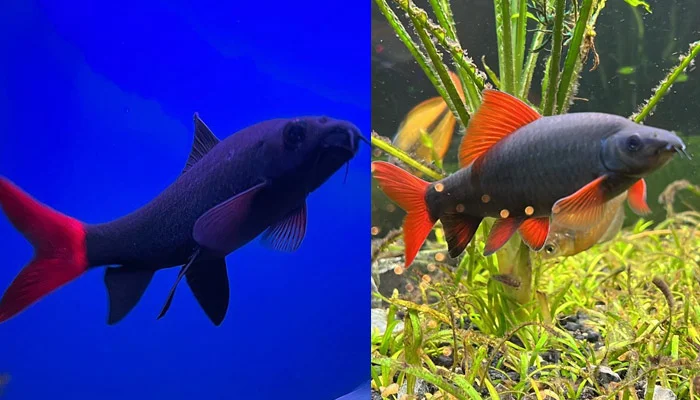
Red-tailed Shark vs Rainbow Shark
The Red Tail Shark and the Rainbow Shark are strikingly similar in appearance but exhibit key differences in both coloration and temperament. Both species are popular in freshwater aquariums and have captivating, contrasting colour patterns on their bodies and tails.
However, it’s in their fins that you can easily distinguish between the two: the pectoral, dorsal, and anal fins are red in the Rainbow Shark, while these same fins are black in the Red Tail Shark. While they share similarities in size, growing between 4 to 6 inches, and have comparable tank requirements and diets, their dispositions are markedly different, almost like night and day.
The Rainbow Shark is known to be more aggressive, particularly towards its own species or similar-looking fish, demanding careful consideration when choosing tank mates. Conversely, the Red Tail Shark, although still territorial, might present fewer challenges in a community tank. Both species require experienced care due to their specific needs and territorial behaviours, but their unique appearance and engaging habits can make them attractive additions to a suitable aquarium.
The choice between the two can depend on personal preference for their appearance and readiness to cater to their differing temperaments and care needs. Overall, these two sharks provide fascinating insights into the diversity and complexity of aquarium fish, embodying a combination of visual appeal with distinctive behaviours and requirements.
Habitat and Tank Requirements
Tank Size
The tank size for a Red Tail Shark plays a crucial role in its overall health and well-being. Given their adult size of approximately 15 centimetres (6 inches) and territorial nature, these sharks require ample space to swim, explore, and establish territories.
A minimum tank size of 115 litres (30 gallons) is often recommended for a single Redtail Shark. However, if planning to keep them with other tank mates, especially other bottom dwellers, a larger aquarium of at least 200 litres (55 gallons) would be more appropriate. This added space allows for better territorial distribution, reducing potential conflicts and stress. In tanks that are too small, Redtail Sharks may become aggressive or stressed, leading to potential health problems and undesirable behaviour.
By providing a suitably sized tank, aquarists can create a more natural and enriching environment, encouraging healthy growth and allowing the Redtail Shark’s captivating behaviours and colours to flourish. The consideration of tank size is not merely a matter of convenience or aesthetics; it is a fundamental aspect of responsible Red Tail Shark care, reflecting an understanding of their unique biological and behavioural needs.
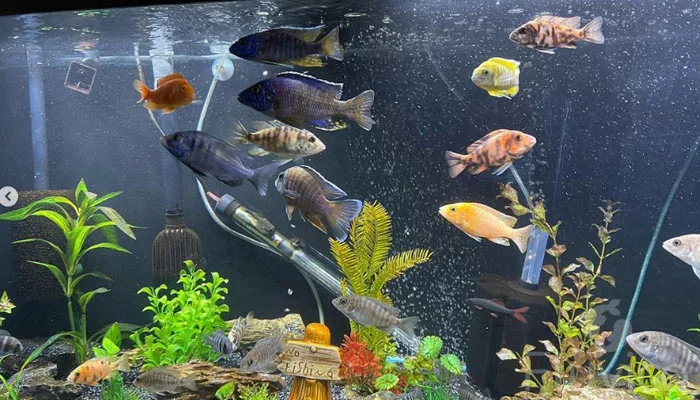
Tank Conditions and Water Parameter
Understanding and adhering to tank conditions and parameters will ensure a thriving environment for the Red Tail Shark, reflecting its natural habitat and promoting healthy growth and behaviour.
- Temperature: 22-26°C (72-79°F), maintained consistently.
- pH Level: 6.8-7.5, a slightly acidic to neutral range.
- Hardness: 5-15 dGH, preferring moderately soft to slightly hard water.
- Ammonia, Nitrite, Nitrate: Close monitoring and control required, ammonia and nitrite should be 0 ppm, nitrates kept low.
- Filtration: Efficient filtration system to keep water clean and oxygenated.
- Substrate: Fine gravel or sandy substrate, allowing for natural bottom-dwelling behaviour.
- Lighting: Moderate lighting to replicate natural environment.
- Plants and Décor: Include plenty of hiding spots, caves, and live plants to allow territorial establishment and comfort.
- Water Flow: Moderate to strong water flow, simulating natural riverine habitat.
- Maintenance: Regular water changes and monitoring to maintain optimal conditions.
Filtration and Substrate
Filtration and substrate are two critical elements in the care of a Redtail Shark.
Filtration:
Filtration plays a vital role in maintaining a clean and healthy environment for the Redtail Shark. Since they are native to fast-flowing rivers, a strong and efficient filtration system is essential. It helps in:
- Removing waste, toxins, and debris from the water.
- Oxygenating the water, providing essential dissolved oxygen.
- Mimicking the natural flow of rivers, promoting natural behaviour.
Choosing a filtration system that provides both mechanical and biological filtration can support the shark’s well-being by maintaining optimal water quality.
Substrate:
Substrate selection is also crucial for Red Tail Shark care. They are bottom dwellers, so the choice of substrate affects their comfort and well-being. Appropriate substrates include:
- Fine gravel or sandy substrate, allowing the shark to sift through and explore as it would in its natural habitat.
- Smooth-edged substrate, ensuring that the delicate underbelly of the shark is not injured during its bottom-dwelling activities.
Inappropriate or rough substrates can cause stress and physical harm, impacting the health and happiness of the shark.
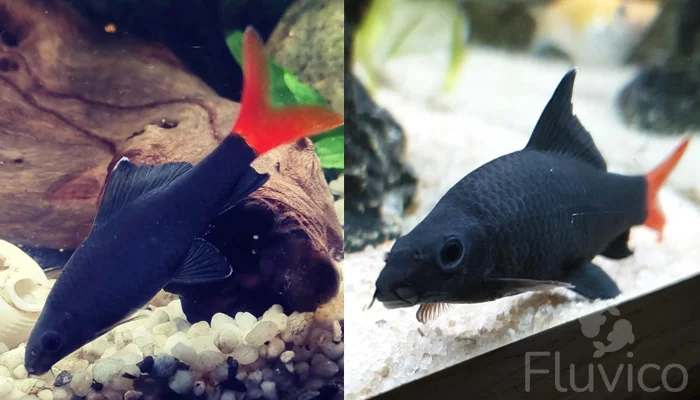
Heating and Lighting
Heating and lighting are two more vital components in the care of a Red Tail Shark, ensuring that their environment replicates their natural habitat. Here’s what you need to know:
Heating:
The Redtail Shark prefers a consistent temperature range of 22-26°C (72-79°F), and a quality aquarium heater is essential in maintaining this.
- Consistency: An adjustable heater with a reliable thermostat helps keep the temperature stable, reducing stress.
- Monitoring: Regular monitoring with a quality aquarium thermometer ensures that the heater is functioning correctly.
Lighting:
While lighting is more flexible with Redtail Sharks, it should still mimic their natural environment.
- Moderate Lighting: Redtail Sharks thrive in moderate lighting that reflects the dappled sunlight of their natural riverine habitats.
- Natural Rhythms: Implementing a day and night cycle with the lighting helps maintain the fish’s natural rhythms.
- Plants and Décor: Consider the needs of live plants if included, and use lighting that encourages their growth while providing hiding spots for the shark.
Together, proper heating and lighting create a comfortable and naturalistic environment for the Redtail Shark. Thoughtful selection and management of these aspects not only meet the physiological needs of the fish but also encourage natural behaviours, contributing to their overall well-being and enhancing the visual appeal of the aquarium.
Plants and Décor
Creating a suitable environment for a Red Tail Shark with compatible plants and decorations is crucial to replicating its natural habitat and providing mental stimulation. Here’s a guide to choosing the right elements:
Compatible Plants:
- Java Fern: Hardy and adaptable to various water conditions.
- Anubias: Provides broad leaves for shelter without being easily damaged.
- Amazon Sword: Offers excellent hiding spots and visual interest.
- Cryptocoryne: Adaptable and provides texture and cover.
- Vallisneria: Simulates the river grasses found in their natural habitat.
Decorations: In addition to plants, decorations provide essential hiding spots and territorial boundaries for Redtail Sharks:
- Caves and Hiding Spots: Essential for allowing the fish to establish territories and retreat when needed.
- Smooth Rocks: Helps in mimicking their natural habitat without causing injury.
- Driftwood: Adds natural aesthetics and can provide additional hiding spaces.
- Avoid Sharp Objects: Ensure that all decorations are smooth-edged to prevent injuries to the fish.
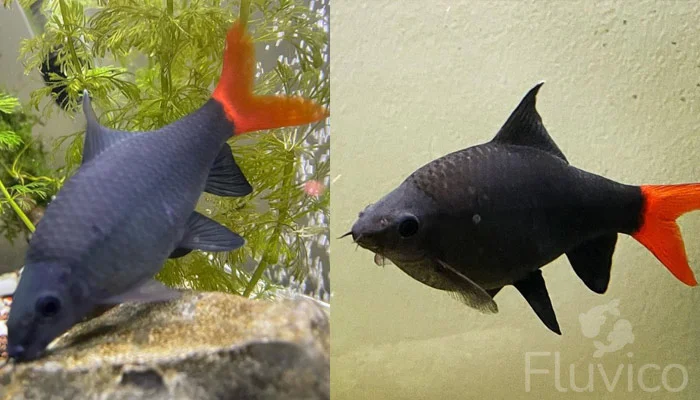
Red Tail Shark Care
Diet and Feeding Regimen
The Red Tail Shark has a diverse diet that reflects its omnivorous nature, and the right feeding regimen is vital for its health and well-being. Diet: The Redtail Shark’s diet in captivity should mimic its natural feeding habits, including a variety of both plant-based and protein-rich foods:
- Flake and Pellet Foods: High-quality omnivorous flake or pellet foods make a suitable base for their diet.
- Live and Frozen Foods: Including brine shrimp, bloodworms, and daphnia provides essential proteins.
- Vegetables: Blanched spinach, zucchini, and peas offer plant matter they naturally consume.
Feeding Regimen: Adhering to a consistent and balanced feeding regimen promotes the Redtail Shark’s health:
- Frequency: Feeding small portions once or twice a day prevents overfeeding.
- Variety: Rotating different food types ensures a balanced diet.
- Monitoring: Observing the fish during feeding helps to adjust portion sizes and prevent leftover food that could affect water quality.
Special Considerations:
- Avoid Overfeeding: Redtail Sharks can become overweight if overfed, leading to health issues.
- Consider Tank Mates: If kept with other species, ensure that the diet meets everyone’s needs, and all fish have the opportunity to feed.
Disease and Health Care
Maintaining the health of a Redtail involves understanding potential diseases and employing appropriate care measures. Here’s an overview: Common Diseases: Redtail Sharks, like many aquarium fish, are susceptible to certain common ailments:
- Ich (White Spot Disease): Recognisable by tiny white spots, often treated with over-the-counter medications.
- Fin Rot: Caused by bacterial or fungal infections, leading to frayed or decaying fins, treatable with appropriate medications.
- Parasitic Infections: Various internal or external parasites can affect Redtail Sharks, requiring specific treatments based on the type of parasite.
Preventative Measures: Prevention is always better than cure, and certain practices can minimize the risk of disease:
- Water Quality: Regular monitoring and maintenance of water parameters reduce stress and the likelihood of diseases.
- Quarantine: New fish or plants should be quarantined before introducing them to the main tank to prevent potential disease spread.
- Diet: A balanced and nutritious diet supports overall health and immunity.
- Regular Observation: Monitoring the Redtail Shark’s appearance and behavior helps in early detection of any health issues.
Health Care: When disease is suspected or diagnosed:
- Consult a Professional: If unsure about the diagnosis or treatment, consult a veterinarian with aquatic experience.
- Follow Treatment Guidelines: Use medications or treatments as directed, considering the specific needs of the Redtail Shark and other tank inhabitants.
- Supportive Care: During and after treatment, maintain optimal water conditions, and consider dietary support to aid recovery.
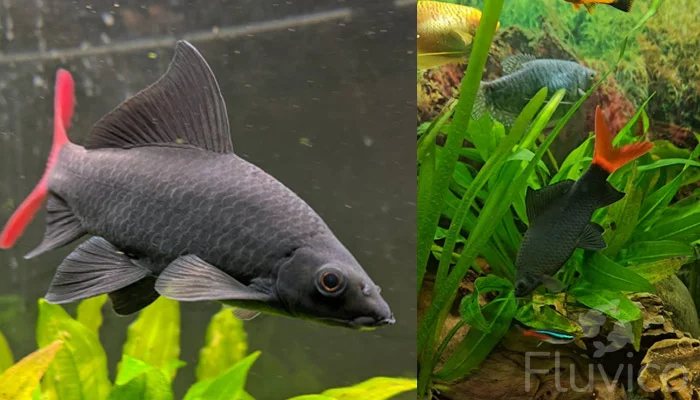
Red Tail Shark Tank Mates
Selecting the right tank mates for a Redtail Shark (Epalzeorhynchos bicolor) can be intricate, especially when considering compatibility with other shark species and fish. Here’s an expanded guide to help you make informed choices: Compatible Tank Mates: Redtail Sharks are adaptable to living with various species, as long as care is taken to avoid those that are too similar in appearance or behaviour:
- Fast-Swimming Community Fish: Tetras, Barbs, Danios (e.g., Zebra Danios) can be good companions.
- Larger Semi-Aggressive Species: Gouramis, Angelfish, and other robust fish that can hold their own.
- Bottom Dwellers with Different Appearances: Loaches (e.g., Clown Loaches) and Corydoras Catfish can work well.
- Certain Shark Species in Large Tanks: Bala Sharks can be housed with careful planning and a spacious environment.
Incompatible Tank Mates: There are specific fish unsuitable for cohabiting with Redtail Sharks:
- Rainbow Sharks: Highly territorial like Redtails.
- Columbian Sharks: Their brackish water requirements are incompatible.
- Slow or Timid Species with Examples: Slow-moving or shy fish like Discus or Dwarf Gouramis may be stressed or bullied.
- Similar-Looking Fish: Including other sharks that resemble the Redtail Shark.
- Small Invertebrates: Such as shrimps and snails, may be preyed upon.
- Other Red Tail Shark: Keeping multiple Red Tail Sharks is generally not advised due to their territorial nature. They often fight with each other, leading to stress and potential harm. A single Red Tail Shark is typically recommended.
Key Considerations:
- Tank Size: Adequate space for territories and movement.
- Individual Temperaments: Consideration of individual behaviours, even among sharks.
- Hideouts and Boundaries: Providing ample hiding spots and territorial divisions.
Choosing compatible tank mates for a Red Tail Shark requires detailed understanding, thoughtful planning, and attention to the specific needs and behaviours of potential companions. Whether including community fish, semi-aggressive species, or even other sharks under certain conditions, the goal is to create a harmonious environment that supports the well-being of all inhabitants.
Respecting the unique characteristics and avoiding species that are too similar or incompatible will allow the Redtail Shark to thrive and contribute positively to the vibrant community of the aquarium.
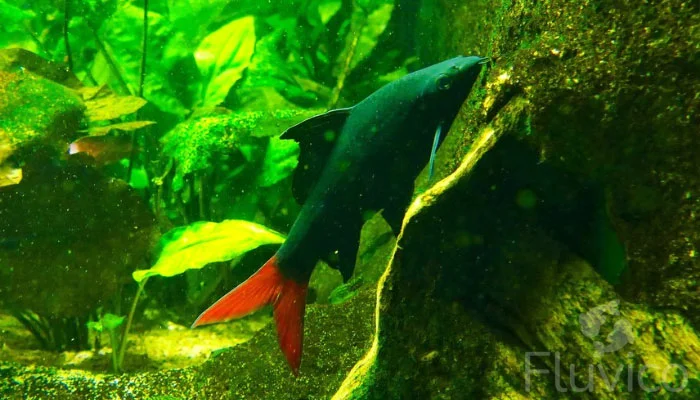
Breeding
Breeding the Red Tail Shark (Epalzeorhynchos bicolor) in the home aquarium is a particularly challenging and rare occurrence. Here’s an overview of what is known and the complexities involved:
Sexing:
- Males: Generally slimmer with a more pointed dorsal fin.
- Females: Often fuller-bodied, especially when carrying eggs.
Environment:
- Water Conditions: Must be optimal, replicating natural habitat as much as possible.
- Hideouts and Planting: Provide secluded spots for laying and protecting eggs.
Breeding Behaviour:
- Mating Rituals: Not well-documented in captivity.
- Spawning: Rarely observed in home aquariums.
Challenges:
- Compatibility Issues: The territorial nature of Red Tail Sharks can make pairing difficult.
- Lack of Specific Information: The exact conditions and triggers for breeding are not well-known.
- Availability of Mates: Distinguishing between males and females can be subtle and challenging.
Breeding Red Tail Sharks in captivity is an intricate task that has rarely been achieved, even by experienced aquarists. Their territorial behaviour, the difficulty in distinguishing sexes, and the lack of detailed understanding of their breeding requirements contribute to the challenges.
If breeding is an essential goal, consulting with professionals or specialist breeders who may have experience with this species would be advisable. The Red Tail Shark’s unique beauty and engaging behaviour continue to attract enthusiasts, but successful breeding within the home aquarium remains an elusive and complex endeavour.
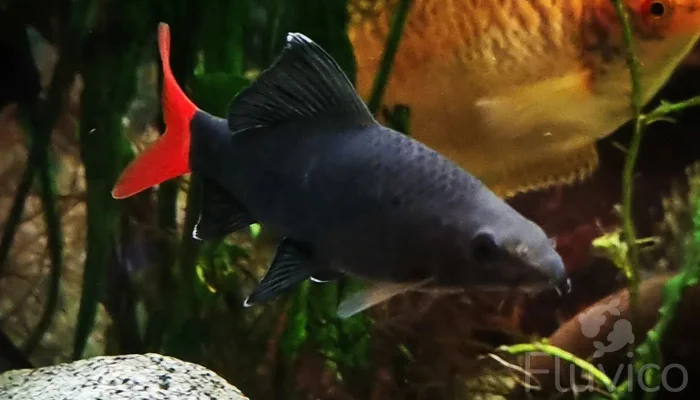
Is a Red-Tailed Shark Right for You?
Keeping a Red Tails can be a rewarding but also challenging experience. If you’re considering adding one to your aquarium, it’s essential to understand both the benefits and drawbacks:
Benefits:
- Striking Appearance: The sleek black body and vivid red tail are eye-catching, adding a unique visual appeal to the aquarium.
- Active and Engaging Behaviour: Their constant movement and exploration provide ongoing interest and entertainment.
- Compatibility with Certain Fish: With careful selection, they can coexist with a variety of tank mates.
- Potential for Controlled Algae Growth: They may nibble on algae, contributing to a cleaner tank environment.
Drawbacks:
- Territorial Behaviour: They can be aggressive, especially with similar-looking or slow-moving fish, requiring careful planning for tank mates.
- Specific Tank Requirements: Red-Tailed Sharks need a specific setup, including hiding spots and plenty of room to roam, which might not suit every aquarium.
- Dietary Needs: They require a varied diet that reflects their omnivorous nature, necessitating thoughtful feeding practices.
- Not Ideal for Beginners: Their specific needs and potential for aggression might prove challenging for novice aquarists.
In conclusion: Is a Red-Tailed Shark right for you? The answer depends on your experience, the current or planned setup of your aquarium, and your willingness to meet their specific needs. They offer beauty and intrigue but require a mindful approach to their care, companionship, and environment. If you’re drawn to their unique appearance and have the capacity to cater to their requirements, a Red-Tailed Shark can become a captivating focal point in your tank.
However, those new to fish keeping or with incompatible tank setups should carefully weigh the challenges before deciding. By understanding the Red-Tailed Shark’s benefits and drawbacks, you can make an informed decision that aligns with your interests, skills, and the well-being of both the shark and other aquarium inhabitants.
FAQ
Are Red Tail Sharks aggressive?
Yes, Red Tail Sharks are territorial and can exhibit aggressive behaviour, especially towards similar-looking fish or their own species. Proper tank setup and careful selection of tank mates are essential.
Can 2 Red Tail Sharks live together?
Housing 2 Red Tail Sharks together is not recommended, as their territorial and aggressive nature towards each other often leads to conflict, stress, and potential harm.
Do Red Tail Sharks jump out of tank?
Yes, Red Tail Sharks can jump out of the tank. It’s advisable to have a weighted lid on the aquarium to prevent them from pushing the lid aside and jumping out.
Why is my Red Tail Shark swimming upside down?
Swimming upside down is often a sign of illness or distress in fish, possibly due to swim bladder issues, water quality problems, or infection. Consult a veterinarian or aquarium expert for an accurate diagnosis and treatment.
What is the white spot on my Red Tail Shark?
The white spot on your Red Tail Shark could be Ich, a common parasitic infection in fish. Prompt treatment with over-the-counter medications and maintaining proper water conditions are usually necessary. Consult an aquarium expert for specific care.
Can you mix Rainbow Sharks with Red Tail Sharks?
Mixing Rainbow Sharks with Red Tail Sharks is generally not recommended, as both species are territorial and can be aggressive towards each other, leading to stress and potential conflict within the tank.
More Reading

15 Types of Cryptocoryne: Which is Best For Your Aquarium Setup?

16 Awesome Low Light Aquarium Plants (Mosses, Ferns & Stem Plants)


18 Types of Aquarium Moss: Photos, Care, Propagation & Growth Guide


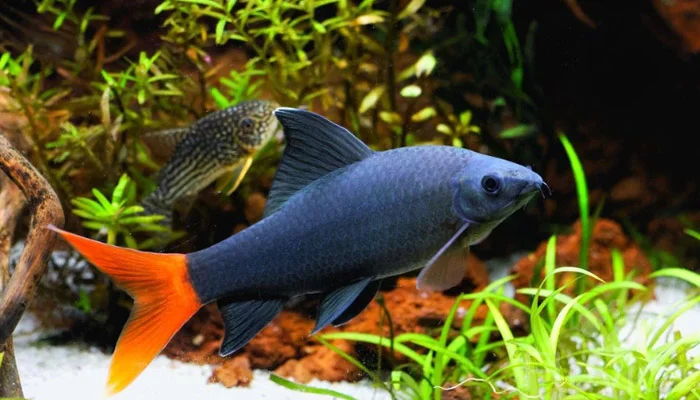

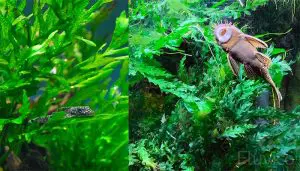

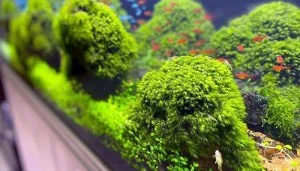
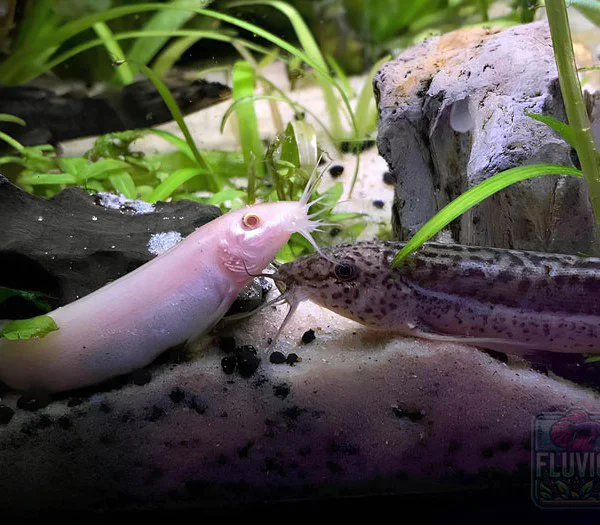
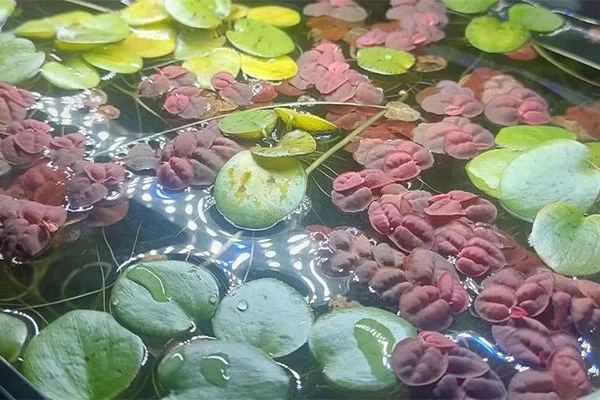
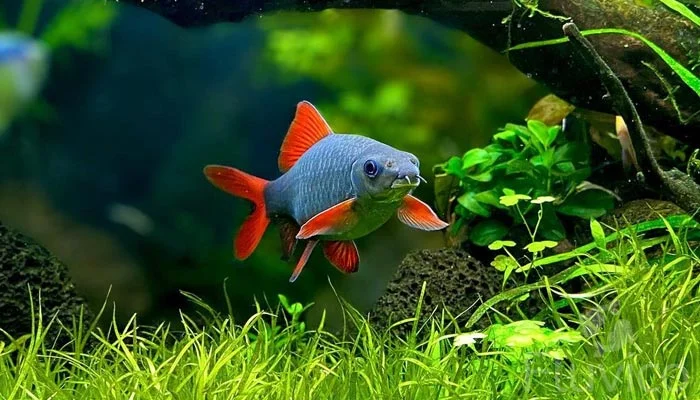


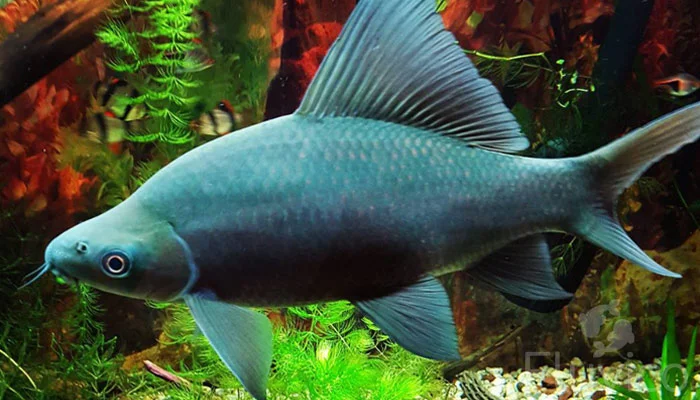
Hope you enjoyed our Redtail Shark Care Guide!
If you have any questions? Ask away, we’re here to help!
All the best,
Daniel